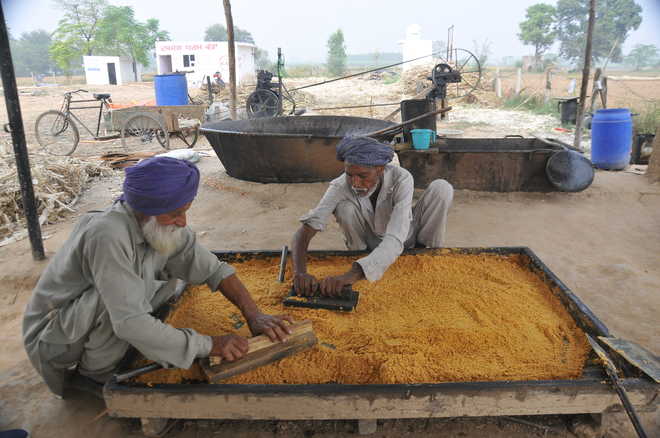
Tribune photos: Vicky Gharu
Jasmine Singh
Sixty six-year-old Basant Singh is popularly known as gur wala Basant in his village, a tag that he wears proudly. A resident of Rauli village in Anandpur Sahib Tehsil, three generations of Basant have been making this desi fudge. Every winter Basant sets up a makeshift jaggery making unit along the Ropar highway, near Chandigarh. His entire family, including his wife, three sons, two daughters-in-law and his younger brother, helps him to make a variety of plain and spice-flavoured gur and shakkar. Since the activity lasts only for the season, Basant and many other jaggery makers like him try to make the most of it.
Mixed with other ingredients like peanuts, til (sesame seeds), coconut, it is a staple after-meal sweet found in most North Indian homes. In fact, not just in food, gur is steeped in Punjab’s entire culture from its folk songs to its many traditions; a symbol of shagun, it finds place in every celebration.
Sugarcane farmers and gur makers like Basant, who sell gur and shakkar for a nominal sum of Rs 40-60 per kg, have a reason to celebrate this year, as the Punjab government has recently hiked the state advisory price (SAP) of sugarcane by Rs 10 a quintal.
As the awareness about the health benefits of gur grows, so do the sales. “This has been the best season in the past five years. The sale is very good. We are getting customers from all across Punjab, Delhi and even Himachal,” says Bunty, Basant’s youngest son. “People who stop to buy gur or shakkar are aware about its benefits, its high iron content, etc.”
Five km along the highway from Basant’s setup, Baldev Singh and his son, too, are busy spreading hot jaggery on a big steel tray. Once this is done, Baldev will use a large spatula to scrape the fudge-like soft gur, cutting it unevenly. The solid part will be used as gur while the granular part will be used as shakkar. Baldev has been making and selling gur for seven years now. Since he is not a farmer, he buys his sugarcane from the mandi (market). He has been lucky this season as a big landlord from Bhucho Mandi has given him sugarcane to run his makeshift ‘venture’, on a profit basis, of course.
While a soft, brown chunk of gur is synonymous with homely comfort, the process of gur making is quite laborious. Ideally, the bhatti (oven) is heated for the entire day, a sugarcane crusher is used to crush juice out of sugarcane which is then collected in a huge pan and boiled.
Making good gur requires skill. Setting up a temporary unit costs around Rs 2,000-Rs 5000, which a jaggery maker can recover even in a day if the going is good and sometimes even more.
However, everything is not so hunky dory. Since these are not recognised units, jaggery-makers have to pay to the land owners on which they set up their units, incurring losses at times.
While not exactly immune, the end-user, however, is more bothered about the health benefits of eating gur than their plight. Celebrity nutritionist Rujuta Diwekar included sugarcane and gur in the list of 10 Indian superfoods in her book Indian Superfoods: Change the Way You Eat, last year.
She advocates eating a mixture of ghee and gur with lunch and dinner in winters. This acts as a perfect cleanser for lungs and intestines and works as a digestive aid as well. This concoction is good for detoxing, too, if you are feeling bloated. The ayurveda celebrates gur for its property to increase majja or health of the bone marrow. Apart from being a natural sweetener, gur is also rich in vitamins and minerals and boosts immunity.
“Have you ever asked your elders why they end every meal with gur?” asks Preeti Bisth, a Patiala-based dietician. She dubs “the gur as a magical potion that is good for digestion. It cleanses the liver by flushing out harmful toxins, purifies blood, boosts resistance against infections, prevents anaemia, and most importantly, it helps women to deal with menstrual pain. So, gur is an ideal solution for many health problems.”
Owing to its growing popularity, gur is finding a favourable place on the winter menu of many hotels and restaurants. Ajaa, a Chandigarh-based restaurant, offers shakkar wali coffee and gur wali kheer. Its owner Rajkanwar Singh
Bhangoo says these are a few of the best selling dishes of the season. “Chefs across the world are experimenting with the humble gur and rustling up interesting dishes,” shares Raj. His personal favourite gur delicacies include gur paarey and Nolen gur ice cream topped with a jaggery glaze and golgappe with gur paani.
Gur may be loaded with benefits but moderation should be the mantra, caution dieticians, as it is high in calories.
As the winter chill sets in, gorge on this superfood in moderation along with other winter favourites — makki ki roti, sarson ka saag with generous dollops of ghee.



























